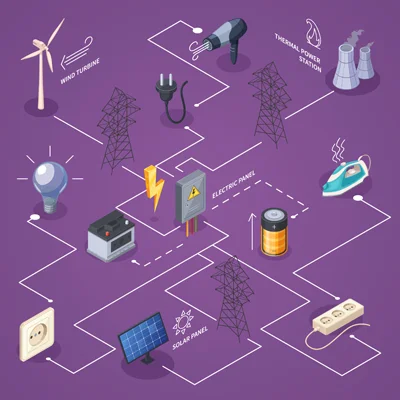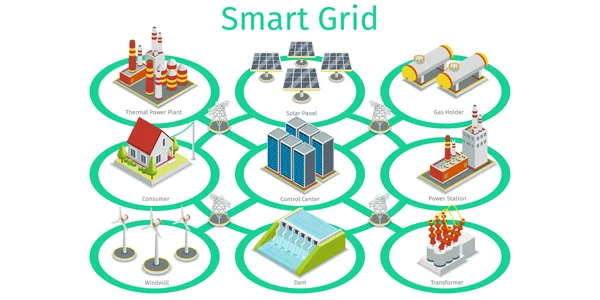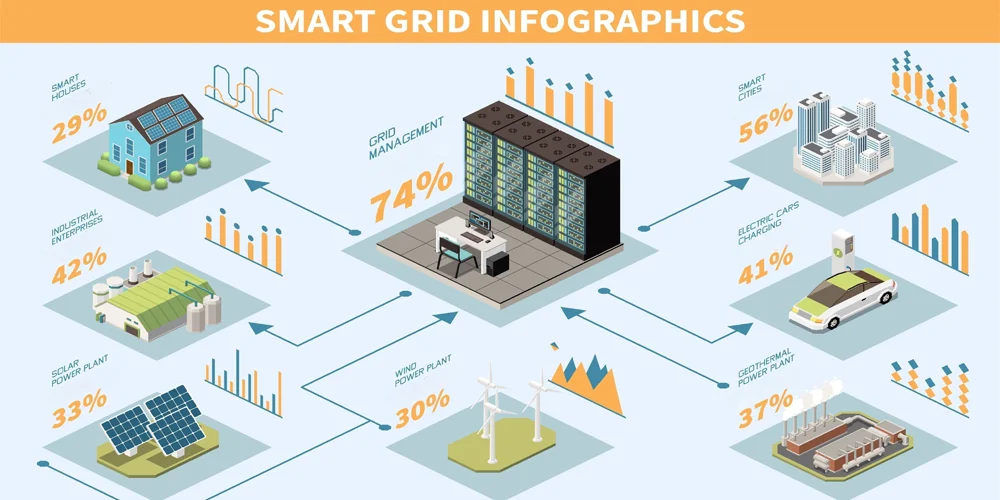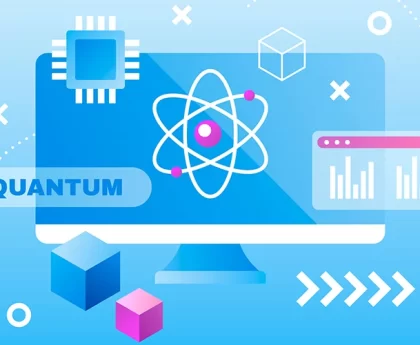Smart Grid: Challenges & Opportunities in Implementation, is an advanced electrical grid system that integrates digital technologies, communication networks, and automation to enhance the efficiency, reliability, and sustainability of electricity generation, transmission, distribution, and consumption.
History of Smart Grid
The concept of a smart grid has evolved over time with technological advancements and changing needs in the electricity sector.
Here’s a brief overview of the history of smart grids:
- Early Developments (20th Century): The early roots of the smart grid can be traced back to the 20th century when electrical grids were first established. However, these grids were primarily designed for one-way electricity flow and lacked advanced monitoring and control systems.
- 1970s – 1980s: Some early efforts toward grid automation and digitalization began to emerge. Technologies like Supervisory Control and Data Acquisition (SCADA) systems were introduced to monitor and control electrical systems remotely.
- 1990s – 2000s: Advancements in computing, communication technologies, and the increasing use of renewable energy sources led to a growing interest in enhancing grid efficiency and reliability. Concepts like demand response, advanced metering, and grid automation gained attention during this period.
- Early 2000s: The blackout of 2003, which affected parts of the United States and Canada, highlighted the vulnerabilities of traditional grids. This event spurred discussions about the need for more resilient and responsive grid systems.
- Mid-2000s – Present: The term “smart grid” gained prominence, representing a comprehensive approach to modernize electricity infrastructure. Governments, utilities, and researchers worldwide began investing in pilot projects and initiatives focused on integrating digital technologies, two-way communication, grid automation, and the incorporation of renewable energy sources.
- Policy and Standards Development: Various countries established policies, regulations, and standards to promote the deployment of smart grid technologies. Organizations such as the International Electrotechnical Commission (IEC) and the Institute of Electrical and Electronics Engineers (IEEE) developed standards to guide the implementation of smart grid systems.
- Continued Advancements: Ongoing technological innovations, such as the Internet of Things (IoT), big data analytics, artificial intelligence (AI), and blockchain, continue to shape the evolution of smart grid systems. These technologies enable more sophisticated monitoring, control, and optimization of electricity networks.
The history of smart grids reflects a progression from traditional electricity infrastructure toward more interconnected, digital, and responsive systems designed to improve efficiency, reliability, and sustainability in the delivery of electricity.

Types of Smart Grid
Smart grids encompass various technologies and functionalities aimed at modernizing and improving electrical grids.
They can be categorized based on different aspects and functionalities:
- Advanced Metering Infrastructure (AMI): This type of smart grid involves the deployment of smart meters that enable two-way communication between consumers and utilities. AMI allows for real-time monitoring of electricity consumption and facilitates features like time-of-use pricing and remote meter reading.
- Grid Automation and Control Systems: Smart grids incorporate automation and control systems to enhance grid reliability and efficiency. These systems include technologies like Supervisory Control and Data Acquisition (SCADA), Distribution Management Systems (DMS), and Outage Management Systems (OMS). They enable real-time monitoring, fault detection, and self-healing capabilities in the grid.
- Distributed Energy Resources (DERs) Integration: Smart grids facilitate the integration of DERs such as solar panels, wind turbines, energy storage systems (like batteries), and electric vehicles. They enable bidirectional power flow, allowing these resources to contribute to the grid while maintaining stability.
- Demand Response Programs: Smart grids offer demand response initiatives that encourage consumers to adjust their electricity usage based on pricing signals or grid conditions. This helps utilities manage peak demand, reduce stress on the grid, and avoid costly infrastructure upgrades.
- Renewable Energy Integration: Smart grids are designed to efficiently integrate renewable energy sources into the grid. They manage the variability and intermittency of renewable power generation through forecasting, storage solutions, and grid balancing mechanisms.
- Cybersecurity and Data Management: With increased digitalization, smart grids focus on robust cybersecurity measures to protect against potential cyber threats. They also emphasize data management systems to handle the vast amount of data generated by smart grid components securely.
- Microgrids: These are localized grids that can operate independently or as part of the larger grid. Microgrids, equipped with smart technologies, offer flexibility and resilience, especially in areas prone to power outages or in remote locations.
- IoT and Advanced Analytics: Leveraging the Internet of Things (IoT) and advanced analytics, smart grids employ sensors, predictive analytics, machine learning, and AI to optimize grid operations, predict maintenance needs, and improve overall efficiency.
Each type of smart grid technology plays a specific role in enhancing the performance, reliability, and sustainability of electrical grids. They collectively contribute to the transformation of traditional grids into more interconnected, responsive, and efficient systems.
Facts of Smart Grid
Absolutely, smart grids represent a significant evolution in the electricity sector.
Here are some key facts about smart grids:
- Enhanced Efficiency: Smart grids optimize the generation, transmission, and distribution of electricity, reducing energy losses and improving overall efficiency compared to traditional grids.
- Improved Reliability: With advanced monitoring and control systems, smart grids can detect faults, isolate problems, and restore power more quickly, minimizing downtime during outages.
- Integration of Renewable Energy: Smart grids facilitate the integration of renewable energy sources, like solar and wind power, into the grid by managing their variable and intermittent nature, thereby supporting the transition to cleaner energy sources.
- Consumer Empowerment: Through smart meters and real-time data, consumers gain insights into their energy usage, enabling informed decisions about consumption habits and potentially reducing costs.
- Demand Response and Flexibility: Smart grids allow for demand response programs, encouraging consumers to adjust their electricity usage during peak times, reducing strain on the grid and avoiding the need for building additional infrastructure.
- Support for Electric Vehicles (EVs): They can accommodate the growing number of electric vehicles by managing charging patterns, optimizing energy use, and potentially supporting vehicle-to-grid (V2G) technology.
- Resilience and Self-Healing Capabilities: Smart grids have self-healing features that enable the isolation of faults and rerouting of electricity, reducing the impact of disruptions and enhancing grid resilience.
- Cybersecurity and Data Management: As smart grids rely on digital technologies and data, robust cybersecurity measures and data management systems are crucial to protect against cyber threats and ensure data privacy.
- Cost Savings: While the initial investment in smart grid technology can be substantial, the long-term benefits in terms of reduced energy waste, improved reliability, and optimized operations can lead to cost savings for utilities and consumers.
- Technological Advancements: Continued advancements in technologies like IoT, AI, and big data analytics will further enhance the capabilities and efficiency of smart grids, paving the way for more intelligent and sustainable energy systems.
Smart grids represent a fundamental shift in how electricity is generated, distributed, and consumed. They offer numerous advantages in terms of efficiency, reliability, sustainability, and consumer engagement, contributing to a more resilient and adaptable electricity infrastructure for the future.
Benefits of Smart Grid
Smart grids offer a multitude of benefits that contribute to a more efficient, reliable, and sustainable electrical infrastructure.
Here are some key advantages:
- Enhanced Reliability: Smart grids detect and respond to disruptions more swiftly, minimizing downtime during outages through advanced monitoring and self-healing capabilities.
- Improved Energy Efficiency: They optimize energy usage, reduce losses in transmission and distribution, and encourage more efficient consumption patterns among consumers.
- Integration of Renewable Energy: Smart grids efficiently accommodate and manage the variability of renewable energy sources, supporting their integration into the grid and reducing reliance on fossil fuels.
- Empowerment of Consumers: Smart meters and real-time data empower consumers with insights into their energy usage, enabling informed decisions about consumption habits and potentially reducing costs.
- Demand Response Programs: These programs encourage consumers to adjust their electricity usage during peak times, reducing strain on the grid and avoiding the need for additional infrastructure.
- Support for Electric Vehicles (EVs): Smart grids can manage the charging patterns of EVs, optimizing energy use and potentially enabling vehicle-to-grid (V2G) technology.
- Enhanced Grid Security: Through robust cybersecurity measures, smart grids ensure protection against cyber threats, safeguarding critical infrastructure and consumer data.
- Cost Savings: Despite initial investment costs, smart grids offer long-term savings through reduced energy waste, improved operational efficiency, and optimized grid management.
- Resilience and Self-Healing: They have self-healing capabilities that isolate faults and reroute electricity, minimizing disruptions and enhancing the overall resilience of the grid.
- Technological Innovation: Continued advancements in technologies like IoT, AI, and big data analytics further improve smart grid capabilities, leading to more intelligent and adaptable energy systems.
Smart grids represent a fundamental shift toward a more adaptable, responsive, and sustainable electricity infrastructure. Their multifaceted benefits not only improve operational efficiency for utilities but also empower consumers and contribute to a cleaner and more reliable energy future.

Why smart grids are required?
Smart grids are essential for several reasons, addressing various challenges and needs in the modern electricity landscape:
- Enhanced Efficiency: They optimize the generation, transmission, and distribution of electricity, reducing energy losses and improving overall efficiency compared to traditional grids.
- Reliability Improvement: Smart grids detect faults, isolate problems, and restore power more quickly, minimizing downtime during outages through advanced monitoring and self-healing capabilities.
- Integration of Renewable Energy: With the increasing adoption of renewable energy sources like solar and wind power, smart grids efficiently manage their variable and intermittent nature, supporting their integration into the grid.
- Consumer Empowerment: Smart meters and real-time data give consumers insights into their energy usage, enabling informed decisions about consumption habits and potentially reducing costs.
- Demand Response and Flexibility: Smart grids facilitate demand response programs, encouraging consumers to adjust electricity usage during peak times, reducing strain on the grid, and avoiding the need for building additional infrastructure.
- Support for Electric Vehicles (EVs): They can accommodate the growing number of electric vehicles by managing charging patterns, optimizing energy use, and potentially supporting vehicle-to-grid (V2G) technology.
- Grid Modernization: Traditional grids were designed for one-way electricity flow and lack advanced monitoring and control systems. Smart grids represent a modernized infrastructure equipped to meet current and future demands.
- Resilience and Self-Healing: Smart grids have self-healing features that enable the isolation of faults and rerouting of electricity, reducing the impact of disruptions and enhancing grid resilience.
- Cybersecurity and Data Management: As smart grids rely on digital technologies and data, robust cybersecurity measures and data management systems are crucial to protect against cyber threats and ensure data privacy.
- Long-Term Cost Savings: Although the initial investment in smart grid technology can be substantial, the long-term benefits in terms of reduced energy waste, improved reliability, and optimized operations can lead to cost savings for utilities and consumers.
In essence, smart grids are required to modernize and transform the electricity infrastructure, improving efficiency, reliability, and sustainability while accommodating evolving energy needs and technological advancements.
Are smart grids eco friendly?
Yes, smart grids contribute to environmental sustainability and are considered more eco-friendly compared to traditional electrical grids.
Here’s how:
- Integration of Renewable Energy: Smart grids efficiently integrate renewable energy sources like solar and wind power. They manage the variability and intermittency of these sources, reducing reliance on fossil fuels and promoting cleaner energy generation.
- Optimized Energy Usage: Through advanced monitoring and control systems, smart grids optimize energy usage, reducing wastage and enhancing overall efficiency. This leads to lower greenhouse gas emissions associated with energy production.
- Reduced Energy Losses: Smart grids minimize energy losses during transmission and distribution, making the overall electricity system more efficient and reducing the need for additional energy generation to compensate for losses.
- Demand Response Programs: By encouraging consumers to shift their electricity usage to off-peak hours or reduce consumption during high-demand periods, smart grids help in balancing the load on the grid. This can potentially reduce the need for additional power plants that rely on fossil fuels.
- Support for Electric Vehicles (EVs): Smart grids facilitate the integration of electric vehicles by managing their charging patterns. This allows for optimized charging during periods of low demand or higher availability of renewable energy, reducing the environmental impact associated with vehicle charging.
- Reduced Dependency on Non-Renewable Resources: By promoting the use of renewable energy sources and optimizing overall energy efficiency, smart grids contribute to reducing dependence on non-renewable resources like coal, oil, and natural gas.
While the eco-friendliness of smart grids depends on various factors and the specific implementation of technologies, their ability to support renewable energy integration, optimize energy usage, and reduce environmental impacts associated with electricity generation make them an important part of efforts to transition to a more sustainable energy future.
Internet of Things: (IoT) Benefits & Building The Urban Future





